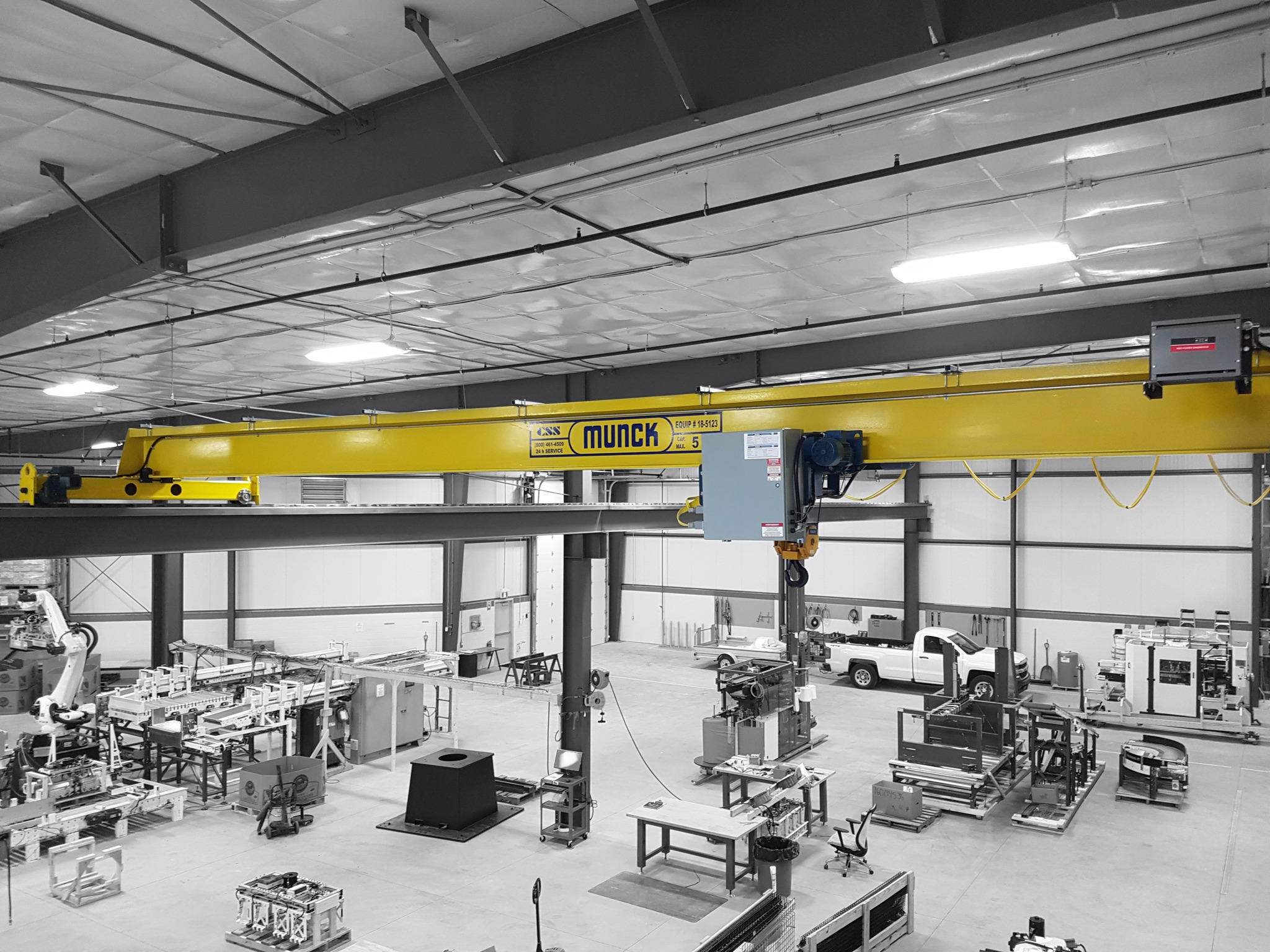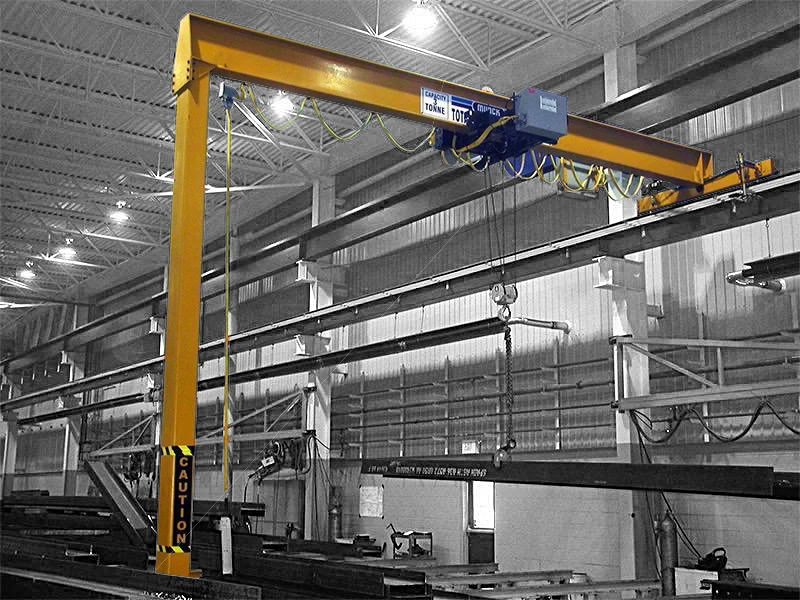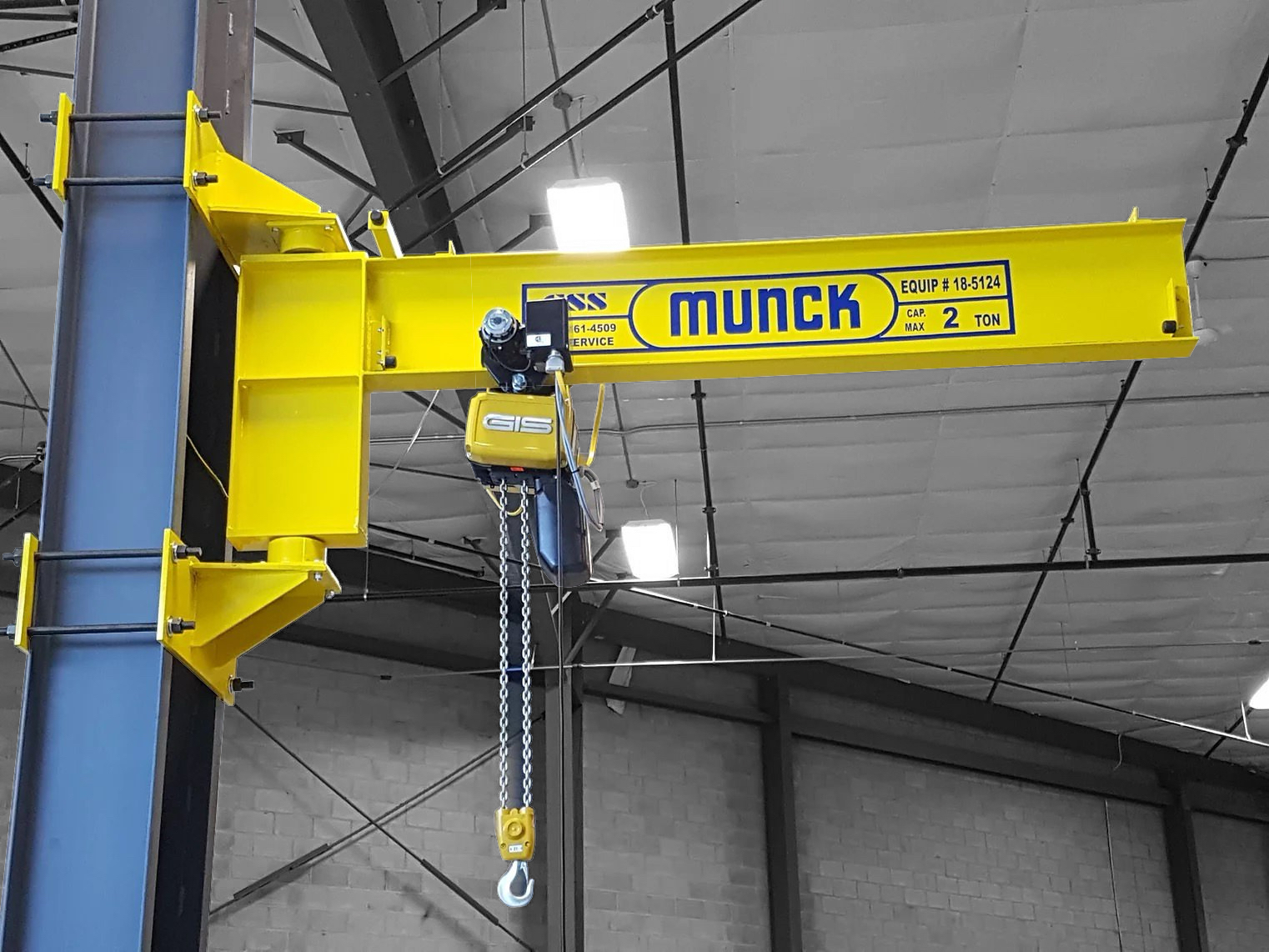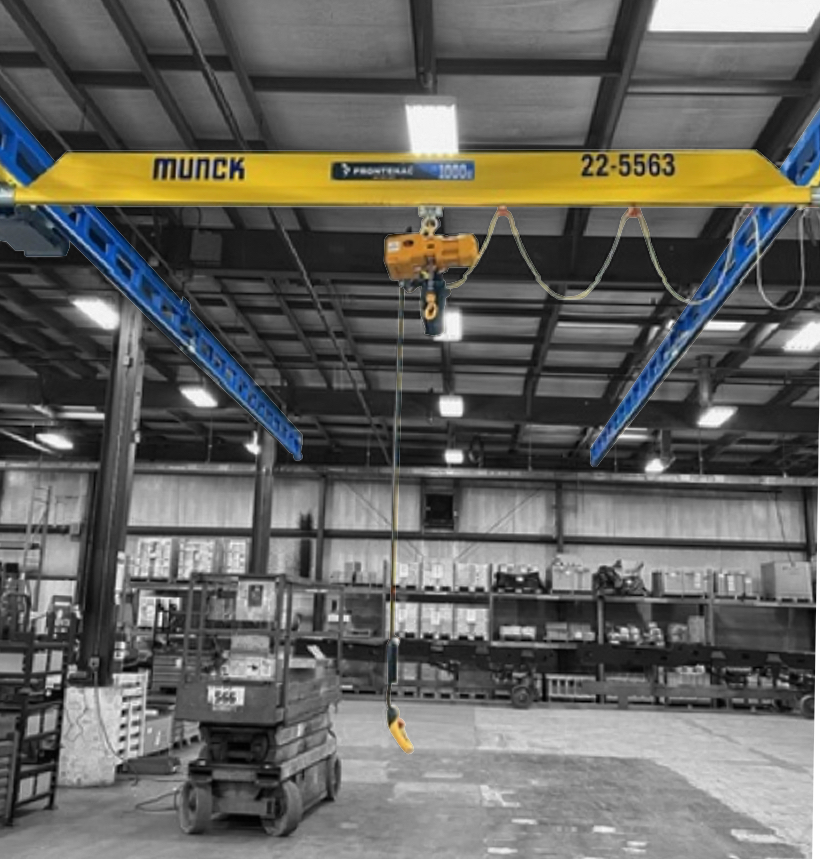When planning or upgrading a facility’s material handling systems, one key question often arises: what kind of crane-or lifting system-fits best? Choices often include overhead bridge cranes (sometimes simply “bridge cranes”), jib cranes, gantry cranes, or workstation cranes. The right choice depends on your loads, space, workflow, structural constraints, and budget.
This article walks through:
- What each crane type is for
- How to compare trade-offs
- A decision checklist
- Example scenarios
Strengths and Limitations of Each Crane Type
Below is a strength and limitation comparison followed by an explanation for each crane type:
| Crane Type | Typical Reach and Coverage | Typical Load Range | Key Advantages | Main Constraints and Considerations |
| Overhead Bridge Crane | Full facility span (bi-directional) | Light to very heavy (tons to hundreds of tons) | High throughput, broad coverage, dual direction control | Requires supporting runway structure, strong building support, higher cost |
| Full to Semi-Gantry Crane | Partial or full span (floor rails) | Light to heavy | No dependence on building structure, portable or semi portable, outdoor possible | Rails in floor, may block traffic, sometimes slower |
| Jib Crane | Local area and swing radius | Light to heavy | Minimal footprint, good for repetitive point lifts | Limited reach, typically one arc of rotation, not full area coverage |
| Workstation Crane | Small cell and workbench area | Light to moderate loads (often < ~2 tons) | Ergonomic, efficient for small zones | Limited coverage, capacity, not for large flows |
Overhead (Bridge) Crane
 An overhead crane, often called a bridge crane, consists of a movable bridge that spans between two runways (rails) that are mounted along the building structure or support columns. A trolley and hoist travel along the bridge when moving loads.
An overhead crane, often called a bridge crane, consists of a movable bridge that spans between two runways (rails) that are mounted along the building structure or support columns. A trolley and hoist travel along the bridge when moving loads.
Strengths:
- Overhead cranes can cover a large rectangular area (full plant floor, bays, etc.).
- Good for frequent and repeated transfers of heavy loads.
- Efficiently interacts with floor traffic (overhead).
- High capacity and flexibility, especially double-girder designs.
Limitations and challenges:
- Requires a robust support structure (building frames, columns, beams).
- Installation can be costly and temporarily disruptive.
- Maintenance access to overhead rails, supports, and crane drives must be considered.
- Height (headroom space) constraints can become a limiting factor.
You’ll want to check whether your building can support the loads imposed by crane runways and end trucks.
If overhead lifting is your focus, see how these systems improve efficiency in real plant settings.
Gantry Crane
 A gantry crane is essentially a bridge crane whose bridge and trolley are supported on legs (gantry legs) that travel on rails or wheels at floor level. Because a gantry doesn’t rely on a building-mounted runway it can be freestanding.
A gantry crane is essentially a bridge crane whose bridge and trolley are supported on legs (gantry legs) that travel on rails or wheels at floor level. Because a gantry doesn’t rely on a building-mounted runway it can be freestanding.
Variants include:
- Full gantry (both legs on rails)
- Semi-gantry (one leg on a runway, the other leg on the floor)
- Portable gantries (wheels and casters)
- Adjustable height gantries
Strengths:
- No need to tie into the building structure, helpful if building frame is weak or you want flexibility.
- Can be moved or repositioned (if designed as a portable or semi-gantry).
- Useful outdoors or in settings where overhead mounting isn’t practical.
Limitations and challenges:
- Gantry rails or tracks on the floor could interfere with forklifts, carts, throughput lanes.
- Floor loading: rails and foundations must support concentrated loads.
- Speed and coverage may be lower than an overhead crane.
- In some layouts or parts of a facility, throughput must cross the gantry rails.
Jib Crane
 A jib crane (or boom crane) consists of a horizontal arm (jib or boom) attached to a vertical mast or supported from a wall or column. Along that arm a hoist can move and the arm can rotate (partial or full circle) around its support point.
A jib crane (or boom crane) consists of a horizontal arm (jib or boom) attached to a vertical mast or supported from a wall or column. Along that arm a hoist can move and the arm can rotate (partial or full circle) around its support point.
There are subtypes:
- Wall-mounted jib
- Ceiling-mounted jib
- Freestanding (floor-mounted) jib
- Mast style with full 360 degree rotation
Strengths:
- Lower cost (both capital and installation).
- Minimal structural demands compared to bridge crane.
- Good for localized lifting tasks (e.g. feeding a machine, servicing).
- Compact footprint.
Limitations and challenges:
- Limited floor coverage.
- Only one directional motion (you lose two-dimensional trolley travel).
- For heavier lifts or longer spans, the structure of the mast and fixing must be robust.
- May require foundation or structural reinforcement of the mounting surface.
Workstation Crane
 A workstation crane (sometimes also called an “ergonomic crane”, or free-standing light bridge crane) is designed to serve a small cell or workbench area.
A workstation crane (sometimes also called an “ergonomic crane”, or free-standing light bridge crane) is designed to serve a small cell or workbench area.
crane is sized and mounted so that an operator can move loads within a defined rectangular or square zone.
These cranes typically have a modest capacity and relatively short spans.
Strengths:
- Low cost and fast installation.
- Ergonomic so operators can move loads easily within a cell.
- Does not require major structural support.
- Good solution when production is organized into cells and material movement is limited to a bounded area.
Limitations and challenges:
- Not suitable for large loads or high throughput across large areas.
- If you later expand, coverage may become a limitation.
- Usually only one axis plus trolley travel, so movement flexibility is limited.
How to Determine the Trade-offs
Below is a structured checklist you can walk through when evaluating which crane option is best.
Decision-making checklist
Load weight, size, and lift frequency
- What is the heaviest load you need to lift and move?
- How often per hour/day do these moves occur?
- Do you need variable hoist speeds or fine positioning?
Coverage area and motion needs
- Do you need full coverage across a bay or whole plant?
- Is movement needed in both longitudinal and lateral directions?
- Would limited swing and/or radius of a jib suffice?
Building structure and support
- Can your building support runway loads?
- Is there space in roof or overhead structure?
- Are there obstacles (ducts, conduits, trusses) obstructing with overhead paths?
Floor constraints and traffic
- Can you install rails in the floor like a gantry?
- Would rails interfere with traffic flows?
- Do you have to maintain clear paths for forklifts, carts or personnel?
Future flexibility and expansion
- Might your layout change in 5-10 years?
- Do you want to relocate the crane or reuse it?
- Is modularity or portability important?
Budget and installation cost
- What is your capital limit?
- What about structural reinforcement, installation downtime, wiring, commissioning?
- Ongoing maintenance cost: rails, drives, alignment.
Headroom and vertical clearance
- How much vertical space is available between floor and roof?
- Will double girder or top-running designs encroach too much?
- Do you need low headroom versions?
Safety, standards, and compliance
- Does the crane need to meet local codes or OSHA/ANSI standards?
- What safety features (end stops, anti-collision, limit switches) are needed?
By scoring options against these variables (e.g. High, Medium, Low), you can determine which crane type comes out strongest given your situation. You can consult this decision matrix to compare different types of cranes across key criteria to evaluate which lifting solution fits your facility’s needs.
Various Scenarios Where Each Choice Plays Out
Scenario A: Heavy maintenance bay in a steel plant
- Loads: 20-50 tons, frequent movement.
- Need full coverage across bay floor to service equipment.
- Building is robust with overhead girders.
Best fit: Overhead bridge crane: you get full area coverage, high capacity, minimal interference with floor traffic.
Scenario B: Outdoor yard with occasional heavy lifts
- Loads: 10-100 tons, but moves are less frequent.
- No overhead structure, often needing relocation.
Best fit: Gantry crane (full or semi): freestanding and mobile with overhead capability, without requiring building connections.
Scenario C: Machine assembly station inside a plant
- Loads: up to 1-2 tons, repetitive feeding and handling.
- Need ease of movement in a defined area.
Best fit: Workstation crane: possibly a small jib crane depending on area shape.
Scenario D: Supporting a repair shop or equipment service zone
- Loads: medium (e.g. 5-10 t)
- The area is bounded so installing rails on the floor is feasible, but building loads are limited
Could use gantry crane for flexibility or overhead crane if robust building support is available. A jib crane might be too limited.
Tips to Avoid Over-engineering
- Don’t oversize “just in case” – oversizing can drive up costs for structure, drives, and safety features.
- Match crane speed and motion to workflow, not peak capacity. Sometimes a crane is rarely used and a more modest solution is wiser.
- If possible simulate material flow and crane paths before committing to rail layout.
- Consider modular systems (kit cranes, modular crane systems) that can be upgraded.
- Factor in lifecycle cost, inspections, maintenance, alignment and rail wear.
- Pay attention to electrification, cable reels, festooning and conductor bars especially for gantry or mobile systems.
